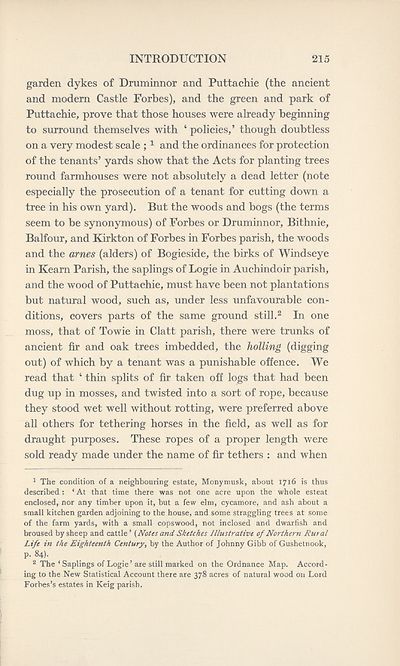Series 2 > Miscellany of the Scottish History Society
(232) Page 215
Download files
Complete book:
Individual page:
Thumbnail gallery: Grid view | List view

INTRODUCTION
215
garden dykes of Druminnor and Puttachie (the ancient
and modern Castle Forbes), and the green and park of
Puttachie, prove that those houses were already beginning
to surround themselves with ‘ policies,’ though doubtless
on a very modest scale ; 1 and the ordinances for protection
of the tenants’ yards show that the Acts for planting trees
round farmhouses were not absolutely a dead letter (note
especially the prosecution of a tenant for cutting down a
tree in his own yard). But the woods and bogs (the terms
seem to be synonymous) of Forbes or Druminnor, Bithnie,
Balfour, and Kirkton of Forbes in Forbes parish, the woods
and the arnes (alders) of Bogieside, the birks of Windseye
in Kearn Parish, the saplings of Logie in Auchindoir parish,
and the wood of Puttachie, must have been not plantations
but natural wood, such as, under less unfavourable con¬
ditions, covers parts of the same ground still.2 In one
moss, that of Towie in Clatt parish, there were trunks of
ancient fir and oak trees imbedded, the holling (digging
out) of which by a tenant was a punishable offence. We
read that ‘ thin splits of fir taken off logs that had been
dug up in mosses, and twisted into a sort of rope, because
they stood wet well without rotting, were preferred above
all others for tethering horses in the field, as well as for
draught purposes. These ropes of a proper length were
sold ready made under the name of fir tethers : and when
1 The condition of a neighbouring estate, Monymusk, about 1716 is thus
described : ‘ At that time there was not one acre upon the whole esteat
enclosed, nor any timber upon it, but a few elm, cycamore, and ash about a
small kitchen garden adjoining to the house, and some straggling trees at some
of the farm yards, with a small copswood, not inclosed and dwarfish and
broused by sheep and cattle ’ (Notes and Sketches Illustrative of Northern Rural
Life in the Eighteenth Century, by the Author of Johnny Gibb of Gushetnook,
P- 84)-
2 The ‘Saplings of Logie’ are still marked on the Ordnance Map. Accord¬
ing to the New Statistical Account there are 378 acres of natural wood on Lord
Forbes’s estates in Keig parish.
215
garden dykes of Druminnor and Puttachie (the ancient
and modern Castle Forbes), and the green and park of
Puttachie, prove that those houses were already beginning
to surround themselves with ‘ policies,’ though doubtless
on a very modest scale ; 1 and the ordinances for protection
of the tenants’ yards show that the Acts for planting trees
round farmhouses were not absolutely a dead letter (note
especially the prosecution of a tenant for cutting down a
tree in his own yard). But the woods and bogs (the terms
seem to be synonymous) of Forbes or Druminnor, Bithnie,
Balfour, and Kirkton of Forbes in Forbes parish, the woods
and the arnes (alders) of Bogieside, the birks of Windseye
in Kearn Parish, the saplings of Logie in Auchindoir parish,
and the wood of Puttachie, must have been not plantations
but natural wood, such as, under less unfavourable con¬
ditions, covers parts of the same ground still.2 In one
moss, that of Towie in Clatt parish, there were trunks of
ancient fir and oak trees imbedded, the holling (digging
out) of which by a tenant was a punishable offence. We
read that ‘ thin splits of fir taken off logs that had been
dug up in mosses, and twisted into a sort of rope, because
they stood wet well without rotting, were preferred above
all others for tethering horses in the field, as well as for
draught purposes. These ropes of a proper length were
sold ready made under the name of fir tethers : and when
1 The condition of a neighbouring estate, Monymusk, about 1716 is thus
described : ‘ At that time there was not one acre upon the whole esteat
enclosed, nor any timber upon it, but a few elm, cycamore, and ash about a
small kitchen garden adjoining to the house, and some straggling trees at some
of the farm yards, with a small copswood, not inclosed and dwarfish and
broused by sheep and cattle ’ (Notes and Sketches Illustrative of Northern Rural
Life in the Eighteenth Century, by the Author of Johnny Gibb of Gushetnook,
P- 84)-
2 The ‘Saplings of Logie’ are still marked on the Ordnance Map. Accord¬
ing to the New Statistical Account there are 378 acres of natural wood on Lord
Forbes’s estates in Keig parish.
Set display mode to:
![]() Universal Viewer |
Universal Viewer | ![]() Mirador |
Large image | Transcription
Mirador |
Large image | Transcription
Images and transcriptions on this page, including medium image downloads, may be used under the Creative Commons Attribution 4.0 International Licence unless otherwise stated. ![]()
| Scottish History Society volumes > Series 2 > Miscellany of the Scottish History Society > (232) Page 215 |
|---|
| Permanent URL | https://digital.nls.uk/127194189 |
|---|
| Attribution and copyright: |
|
|---|
| Description | Over 180 volumes, published by the Scottish History Society, containing original sources on Scotland's history and people. With a wide range of subjects, the books collectively cover all periods from the 12th to 20th centuries, and reflect changing trends in Scottish history. Sources are accompanied by scholarly interpretation, references and bibliographies. Volumes are usually published annually, and more digitised volumes will be added as they become available. |
|---|


